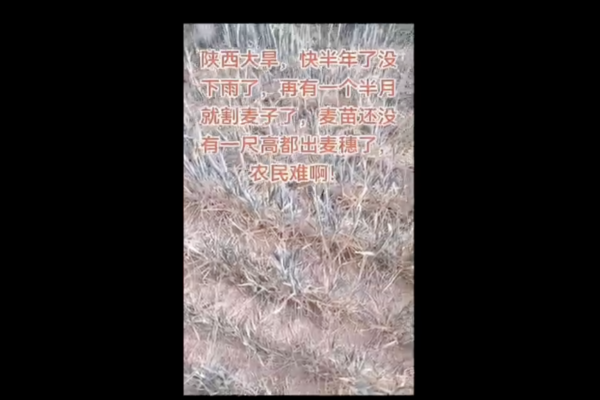In recent months, parts of the Yellow River basin have been experiencing persistent high temperatures and scarce rainfall, leading to severe drought in areas such as Baoji and Xianyang in Shaanxi Province. This has dealt a devastating blow to local farmers and their crop production. Farmers affected by the drought in Shaanxi expressed their sadness as the wheat harvesting season approaches, foreseeing reduced yields due to lack of irrigation water. Many locals have taken to sharing videos, praying for rain to come and alleviate the dry spell.
Mainland media reports indicate that the weather situation in Shaanxi Province is dire, with the drought worsened since last winter and spring. Particularly since April, the average rainfall in the province has decreased by 80% compared to normal years, while temperatures in the Guanzhong region have been consistently 10 degrees Celsius higher than usual. Meteorological authorities forecast that Shaanxi will continue to face high temperatures and arid conditions in the coming period, posing significant challenges to agricultural production, especially in the sowing of spring crops like corn.
According to the China Meteorological News Agency, this spring Shaanxi has experienced below-average precipitation and visible signs of drought. Since late March, the average rainfall in the province has been the lowest since 1961, while the average temperature ranks as the third highest for the same period since 1961.
Official reports have shown severe land cracking in the region. Recently, a villager named Qian Cheng (pseudonym) from Baoji, Shaanxi, shared with reporters that after a brief snowfall in the days following the Chinese New Year, there has been no rain, exacerbating the drought. The main crops in the area include wheat, corn, and soybeans. Typically, wheat should be ready for harvest by the end of June to early July, but due to the drought, the wheat crop is almost nonexistent. The recently planted corn is also unlikely to thrive without sufficient water. The local pepper production, well-known in the area, has suffered significant losses due to lack of water rendering even the buried fertilizers ineffective.
Qian Cheng lamented, “The wheat is all dried up now, most of it withered when it reached about 30 centimeters high. The wheat leaves are all dried, this year we might face total crop failure, with nothing left.”
He expressed concern about the extreme hardship farmers are facing, struggling to make a living. With eight to nine hundred catties of grain from a mu of cornfield, and six to seven hundred catties of wheat sold for only 1.2 yuan per catty, the income is meager, leading families to save the leftover grains. However, with the ongoing drought, they fear there might be no food to eat next year.
Qian Cheng highlighted that farmers are compelled by the local government to uproot the lucrative pepper trees that sustain their livelihoods and plant wheat instead, a decision met with reluctance and helplessness. They voiced concerns about a possible food shortage in the country, as national food supplies may be insufficient.
On April 24th at 8 pm, the Shaanxi Provincial Meteorological Observatory issued an orange alert for meteorological drought: currently, areas including most of Yulin, northern Yan’an, eastern Xi’an, southern Weinan, and other regions are experiencing varying levels of drought severity, ranging from mild to extreme, with predictions of further drought development in the absence of significant rainfall in the upcoming week. This situation is expected to significantly impact the growth of summer crops such as grains and oilseeds, as well as economic fruit trees.
A villager named Mei Ling (pseudonym) from Weinan, Shaanxi, expressed that this year, with the absence of rain and irrigation water for wheat, a substantial reduction in yield is certain, much worse than last year. Farmers in the region are left in tears.
She mentioned that the critical growth period for wheat is underway, with harvesting expected in one to two months, while the land is now at risk of catching fire. She questioned why artificial rainfall operations are not implemented and why reservoirs are not releasing water.
Numerous people in Shaanxi have resorted to sharing videos, pleading for rain. A blogger seeking assistance mentioned the near-complete crop failure of wheat, depicting the hard work of farmers over the year amounting to no hope. Many households are on the brink, unable to sustain themselves without rain. The immense suffering and losses brought by this severe drought are beyond words. Prayers are sent to the heavens, hoping for rain to bring vitality and hope to Shaanxi.

